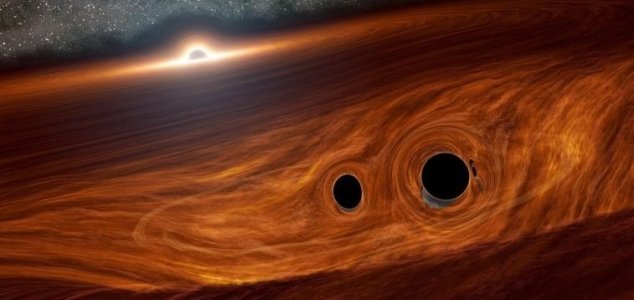Light flare from merging black holes detected
Posted on Monday, 29 June, 2020

Merging black holes produce a visible flare of light. Image Credit: Caltech / R. Hurt (IPAC)
For the first time ever, astronomers have picked up the light produced by two colliding black holes.
When two black holes are on a collision course, they will begin their dance of death by spiralling around one another before finally colliding - producing ripples through space and time known as gravitational waves which, thanks to recent advancements, scientists are now able to detect.
For some time however, astronomers have speculated that merging black holes might also produce visible light in the form of a flare bright enough to be picked up by optical telescopes here on Earth.
Until now the idea of detecting such a phenomenon seemed like a long shot, but just recently, the team at Caltech's Zwicky Transient Facility (ZTF) near San Diego picked up an anomalous light signal that could in fact have been produced by the merger of two black holes.
The event itself was identified on May 21st, 2019 by two independent gravitational wave detectors, which gave scientists the opportunity to hunt for signs of a visible flare in the same region.
"This detection is extremely exciting," said study co-author and NASA astrophysicist Daniel Stern.
"There's a lot we can learn about these two merging black holes and the environment they were in based on this signal that they sort of inadvertently created."
"So the detection by ZTF, coupled with what we can learn from the gravitational waves, opens up a new avenue to study both black hole mergers and these disks around supermassive black holes."
Source: SciTech Daily
https://www.unexplained-mysteries.com/news/337870/light-flare-from-merging-black-holes-detected
Thanks to: https://www.unexplained-mysteries.com
https://youtu.be/sTom19W6lcE
Astronomers have discovered the second most distant quasar ever found, using the international Gemini Observatory and Cerro Tololo Inter-American Observatory (CTIO), Programs of NSF’s NOIRLab. It is also the first quasar to receive an indigenous Hawaiian name, Pōniuāʻena. The quasar contains a monster black hole, twice the mass of the black hole in the only other quasar found at the same epoch, challenging the current theories of supermassive black hole formation and growth in the early Universe. Stay Tuned!
Posted on Monday, 29 June, 2020

Merging black holes produce a visible flare of light. Image Credit: Caltech / R. Hurt (IPAC)
For the first time ever, astronomers have picked up the light produced by two colliding black holes.
When two black holes are on a collision course, they will begin their dance of death by spiralling around one another before finally colliding - producing ripples through space and time known as gravitational waves which, thanks to recent advancements, scientists are now able to detect.
For some time however, astronomers have speculated that merging black holes might also produce visible light in the form of a flare bright enough to be picked up by optical telescopes here on Earth.
Until now the idea of detecting such a phenomenon seemed like a long shot, but just recently, the team at Caltech's Zwicky Transient Facility (ZTF) near San Diego picked up an anomalous light signal that could in fact have been produced by the merger of two black holes.
The event itself was identified on May 21st, 2019 by two independent gravitational wave detectors, which gave scientists the opportunity to hunt for signs of a visible flare in the same region.
"This detection is extremely exciting," said study co-author and NASA astrophysicist Daniel Stern.
"There's a lot we can learn about these two merging black holes and the environment they were in based on this signal that they sort of inadvertently created."
"So the detection by ZTF, coupled with what we can learn from the gravitational waves, opens up a new avenue to study both black hole mergers and these disks around supermassive black holes."
Source: SciTech Daily
https://www.unexplained-mysteries.com/news/337870/light-flare-from-merging-black-holes-detected
Thanks to: https://www.unexplained-mysteries.com
https://youtu.be/sTom19W6lcE
Astronomers have discovered the second most distant quasar ever found, using the international Gemini Observatory and Cerro Tololo Inter-American Observatory (CTIO), Programs of NSF’s NOIRLab. It is also the first quasar to receive an indigenous Hawaiian name, Pōniuāʻena. The quasar contains a monster black hole, twice the mass of the black hole in the only other quasar found at the same epoch, challenging the current theories of supermassive black hole formation and growth in the early Universe. Stay Tuned!






 Sat Mar 23, 2024 11:33 pm by globalturbo
Sat Mar 23, 2024 11:33 pm by globalturbo

